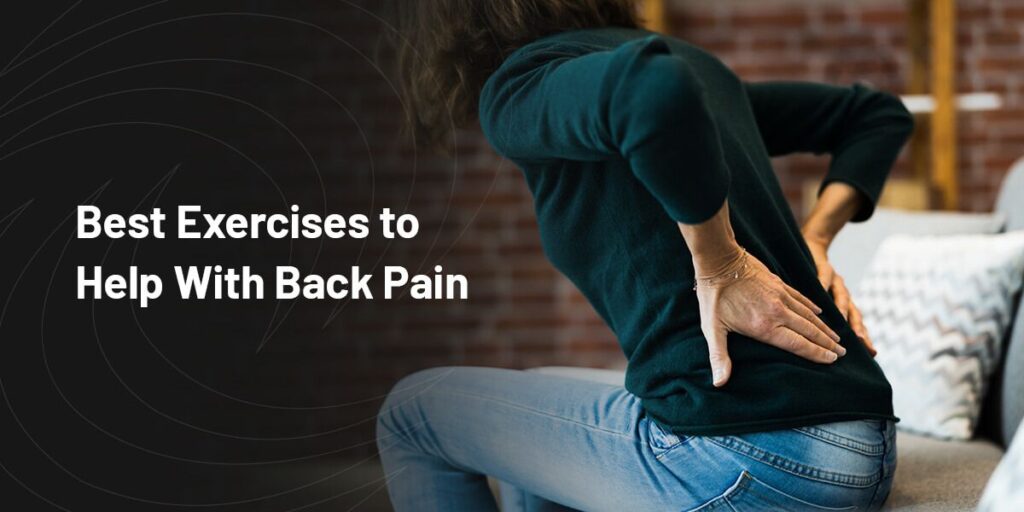

Back pain, especially lower back pain (LBP), is widespread. Almost everyone will experience back pain as an acute episode or chronic condition during their lifetimes. In fact, up to 23% of adults worldwide have chronic low back pain.
While back pain makes everyday tasks more challenging, certain activities can help relieve back pain, including exercise. If you suffer from chronic back pain, pain that has lasted for 12 weeks or more, it’s best to consult with a medical professional before attempting any new exercise.
Physiotherapy exercises for back pain can strengthen your back, stomach and leg muscles and support your spine, relieving back pain. An exercise program for nonspecific chronic back pain must target muscular strength, flexibility and aerobic fitness. Core muscular strength can assist in lumbar spine support, flexibility improves range of motion and movement and aerobics increases blood flow and nutrients to the soft tissues of the back.
Exercise stretches, repairs and strengthens the muscles of the back. Increased blood flow and nutrients improve the healing process and reduce stiffness. The improved flexibility of ligaments and tendons prevents injuries and back pain by keeping the connective fibers from tearing under stress.
Physical activity as a treatment for low back pain is essential in assisting in completing daily activities. However, different exercises result in varying levels of effectiveness. Keep in mind that too much or too little physical activity can agitate low back pain instead of relieving it.
You must know the cause of your pain before you can begin treating it. Sciatica and lower back pain are different, but both are symptoms, not diagnoses. People with acute or chronic back pain may be more prone to sciatica pain, but many risk factors exist.
The following exercises help relieve lower back pain, which may reduce sciatic pain. The effectiveness of exercise depends on the type and cause of the pain. Consult a medical professional before attempting any exercises, as some may not be recommended for your specific condition and could worsen it.
Bicycling increases endurance and the performance of the heart, lungs and musculoskeletal system, including the spine. It’s less jarring to the spine than other aerobic exercises. Specifically, spinning on a stationary bike provides a more intense workout with minimal stress on the spine.
Here’s how to exercise on a bike to help with black pain:
Walking is good for low back pain because it’s a low-impact exercise that offers the benefits of regular physical activity without aggravating the muscles and tendons of the lower back. It uses and stretches muscles in your back, is easy on your joints and can reduce bone and muscle loss. The amount and type of muscles activated depend on the slope and speed at which you walk.
To get the most benefit out of your walks, you should:
Swimming helps reduce back pain by alleviating pressure on your joints, increasing back strength and improving circulation. It’s a low-impact exercise because the buoyancy of the water will support your weight, reducing stress on your joints and spine and allowing for a broader range of motion.
When swimming to relieve low back pain, you should:
Resistance training reduces low back pain, functional disability, stress and creatine kinase — a chemical in the bloodstream that tends to be higher when muscles are damaged or stressed. It’s an effective treatment for low back pain because it increases the function of your muscles, muscle mass, muscle strength and range of motion.
Some resistance exercises you can do to alleviate back pain include:
Yoga is a mind-body therapy that treats back pain and stress. It’s a gentle practice that stretches and strengthens back muscles, improving mobility. Doing a yoga flow involves going through a series of poses or postures. Many yoga postures are good sitting exercises for lower back pain.
To practice yoga safely, you should:
Similar to how some exercises relieve back pain, others worsen it. You must avoid putting too much stress on your spine when dealing with back pain. Most of the discomfort felt during workouts should disappear as the muscles strengthen. However, there’s a difference between discomfort and pain. If you can’t work through the discomfort, you need to consult with a doctor, as the exercise you’re doing may be aggravating your lower back pain.
Here are some of the exercises to avoid when you have back pain.
There’s a link between running and upper back pain. People who experience upper back pain after running long distances might suffer from bad posture. Slouching flexes your spine and strains the posterior muscles over time, resulting in injury. The stress of long-distance running exasperates the problems caused by poor posture.
Running stresses your entire body, including your back and joints. When dealing with low back pain, you want to decrease the strain on your back, not increase it. Instead of running for back pain, you could opt for brisk walking.
Standing toe touches is a deep stretch that tests your flexibility. However, standing toe touches won’t feel great when you suffer back pain. You should avoid standing toe touches because:
While some resistance training can help lower back pain, heavy lifting should be avoided. Heavy lifting is a common cause of muscle strain because it is easy to overstretch or put too much force on your body. You might twist or bend awkwardly when you lift heavy weights, causing pain and injury.
If you suffer from low back pain, you shouldn’t lift weights over your head or on your shoulders. These types of lifting will stress your spine. It’s best to lift lighter weights in a slow, controlled way to prevent further injury or pain in your back. You should always use proper form when lifting weights and avoid lifting more than you can handle.
For many people, any sitting exercise can cause low back pain, especially situps. Situps push the spine against the floor and employ the hip flexors. If the hip flexors are too tight, they can tug on the lower spine. The position and movement also work against the natural curvature of your spine, which can lead to pain, discomfort or injury.
Your core, the group of muscles that support your body, must be strong for you to do situps. When you have low back pain, your back may not be strong enough to support your core during the exercise. Attempting this exercise with a weak core will cause the muscles in your back to strain. Any amount of stress on your lower back can worsen your pain and condition.
Repeated flexing and extending of the spine cause many back injuries. Like with situps, when you push your back to the floor to do crunches, you work against your spine’s natural curvature. Hip flexors that are too tight will pull your spine. All this added stress will only aggravate your injury. Additionally, crunches can cause neck pain if not performed correctly, and don’t target the areas you need to reduce back pain.
The Desert Institute for Spine Care (DISC) is an orthopedic spine center in Phoenix, Arizona. Our team of surgeons treats various spinal conditions, including herniated discs, sciatica, chronic back pain, lower back pain and middle back pain. Our practice uses innovative, cutting-edge technology and a customized approach to patient care — the treatments we offer range from nonsurgical to least-invasive and minimally-invasive spine surgery.
DISC surgeons are recognized leaders in the industry of noninvasive, least-invasive and minimally invasive orthopedic surgery and have a collective 50 years of experience in the field. If you’re ready to schedule an appointment, contact us online or call us at (602) 944-2900.